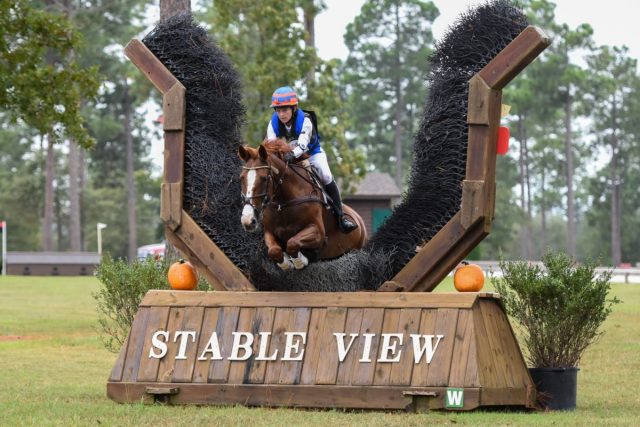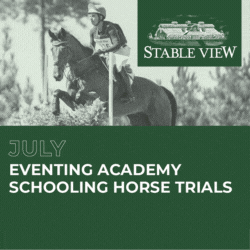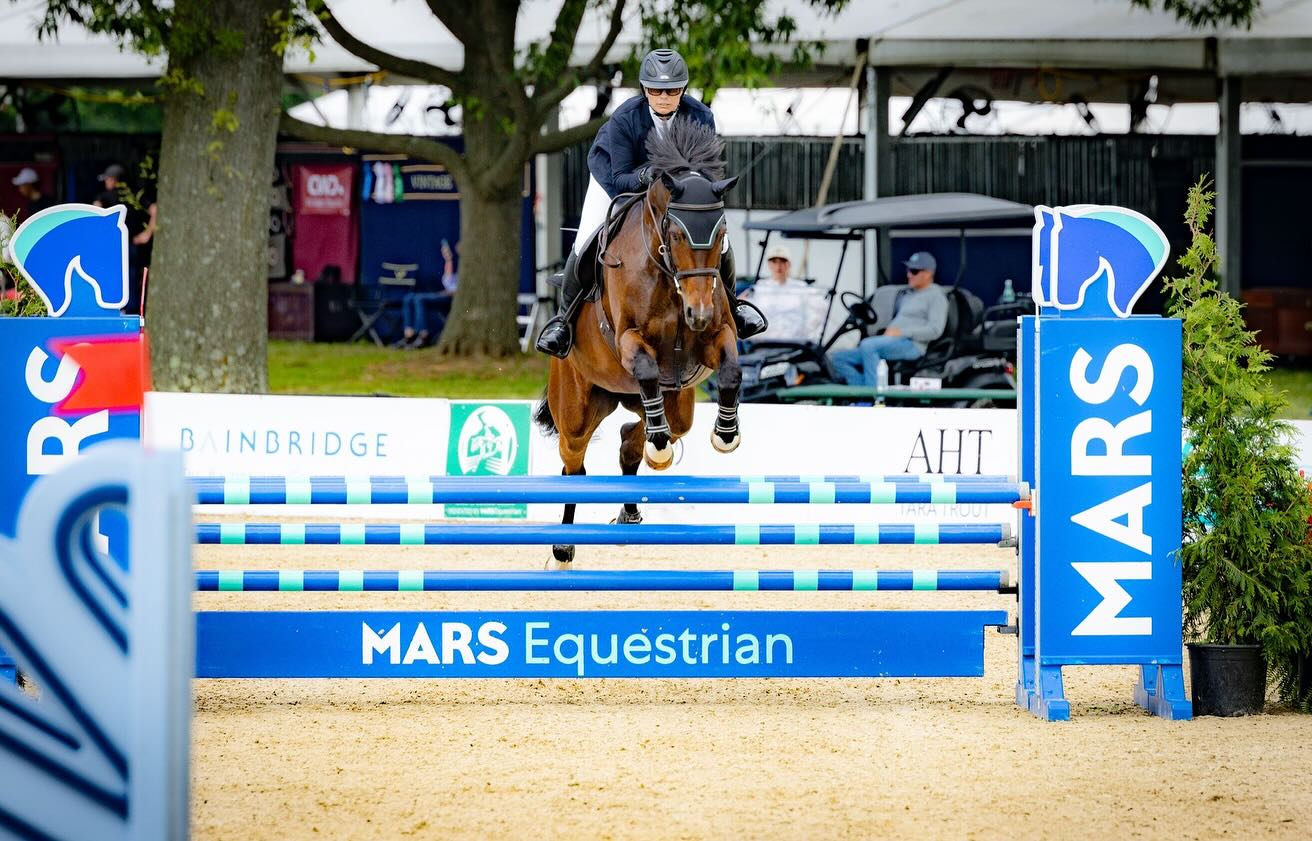
Meaghan Marinovich-Burdick and Riviera Lu at Red Hills. Photo by Shannon Brinkman.
A first FEI win is always a memorable one, but especially so for Meaghan Marinovich-Burdick who topped the leaderboard of the CCI3-S at Red Hills International Horse Trials this weekend with 14-year old Brazilian Sport Horse mare, Riviera Lu.
Through no fault of the event or location itself, Meaghan has a bit of a sad history with Red Hills. Last year she returned to the event for the first time since 2008, when her coach Darren Chiacchia suffered a rotational fall that left him seriously injured and in a coma for forty two days. At that same event, her friend Missy Miller also lost her horse as a result of a fall.
“I have a lot of previous demons here that I’ve had to get over, so I think it’s pretty neat to have my first FEI win here – it adds a very good memory,” she says.
Hoofprints Around the Country and Across the Pond
Meaghan was bitten by the horse bug at an early age and was naturally drawn to eventing. She rode at two barns when she started out taking riding lessons – a hunter barn and an eventing barn – in order to be able to take more than one lesson a week. Soon enough, it became apparent which discipline she favored.
“I used to sleep over at my friend’s house who lived near both barns and I would purposely skip my hunter lessons on Saturday morning so I could go to the eventing barn to clean stalls,” she said.
“The hunter trainer called my mom and said, ‘This is the second week where she hasn’t shown up, I don’t think she is interested in horses.’ So my mom calls my friend’s mom and the mom said, ‘No, I dropped them off hours ago. They are cleaning stalls.’”
Meaghan’s mom sat her down that evening to ask what was going on and why she was playing hooky from the hunter barn.
“I said I would rather take care of the eventing horses and be with them than take the hunter lessons. The rest is kind of history.”

Meaghan Marinovich and Riviera Lu. Photo by Shelby Allen.
Meaghan’s eventing education and career have left hoof prints across the country – and across the pond – from her home state of Minnesota, where her first event horse took her through Training level, to her first working student position with Tracey Amaral on Martha’s Vineyard in Massachusetts, who would set her down the Young Riders path.
In Ocala, Meaghan spent time riding with Olympian Darren Chiacchia and purchased the Trakehner stallion Ahlerich, who he rode through the then three-star level, from him. Ahlerich would take Meaghan on to win team gold for Area IV in the now two-star at the 2006 Young Rider Championships.
When Meaghan went off to college, she headed overseas to Hartpury College to study equine sports science and further her dream of riding professionally. Ahlerich joined Meaghan across the pond where they rode with the elite squad at the Hartpury Equine Academy and took Meaghan to her first Advanced horse trials. While training in England, they contested the likes of Aston le Walls, Barbury Castle, Houghton Hall.
After earning a graduate degree from Hartpury in sports management, Meaghan made the choice to return to the US in 2014 to continue her career there while being closer to family. To this day, her business Marinovich Eventing, can be found operating out of Aiken in the winter and out of her parents’ Powder River Ranch in summer — a 400 acre working farm just outside of Des Moines, Iowa that produces soybeans, corn, and alfalfa hay and also hosts an annual polo charity event – in the summer.
Linking Ireland to Brazil
The name Rock Phantom might ring a bell to you. The Irish Sport Horse Gelding has been competing with Nilson Moreira da Silva at the Advanced and four-star levels since 2019, earning a top 10 finish in the CCI4-L at the Tryon International 3-Day Event last fall. At the end of last year, he was purchased by Edy Hunter Rameika and now joins Sara Kozumplik’s string. But what does “Rock” have to do with Meaghan and Riviera? In a way, he helped them find each other.
Meaghan sourced Rock Phantom (Sprit House xx – Ballycroy Rose, by Clonakilty Hero) from Carol Gee of Fernhill Sport Horses in 2015, importing him as a 4-year-old having only seen him from a video. Flash forward a few years into Rock’s eventing career with Meaghan and “I was having the most difficult time with him,” she says. That same year, 2018, she began riding with Nilson, who offered to help her with the gelding. Ultimately, they ended up trading horses – Rock became Nilson’s and Meaghan took on a different chestnut called, Red Lion.
Meaghan sadly had to part with Red Lion too soon – he had to be put down in August 2019 – but next month another special chestnut would come into her life. Nilson had been helping Meaghan look for an additional horse to add to her string and helped connect her with Luciano Miranda Drubi, who he used to work for. Luciano represented Brazil at the 1995 Pan American Games 1996 Olympics with Riviera’s grand dam Xilena, where Nilson groomed for them at both events. He later on bred Xilena, stamping horses from his program with the ‘Lu’ suffix.
Meaghan took another chance on a horse after seeing her only via video, and Riviera Lu (Rembrandt Jmen x Ravena 3J, by Diapason des Gaves) arrived stateside in September 2019.

Meaghan Marinovich-Burdick and Riviera Lu at Red Hills. Photo by Shannon Brinkman Photography.
Riviera Goes to the Red Hills
Meaghan and Riviera did their first event as a new partnership in November 2019, stepped up to Intermediate just prior to the pandemic hitting in 2020, and were able to finish out the year with a strong fall 2020 season ending with a CCI3-L completion at the Hagyard Midsouth Three-day Event. The pair went on to move up to the Advanced level early last year and successfully completed the very tricky inaugural CCI4-S at the Kentucky Three-Day Event, followed by Jersey Fresh International CCI4-L in May.
“It’s been a very fun ride,” Meaghan says of her and the chestnut mare’s journey together so far.
Now in their third year together, the partnership is still relatively early days and Meaghan is continuing to figure out how to get the most out of her fiery chestnut mare.
“I’ve been switching her bit up lately and I ran her cross country [at Red Hills] in a rubber pelham with rubber around the chain,” Meaghan said. “I didn’t end up really having much control so I think that’s where the time penalties came from, but she’s so honest and I can put her in front of anything and she’ll jump it.”
Even so, the pair was the second fastest round over a course which ten others in the division were unable to complete. They added only 5.2 time penalties to their dressage score, which was a personal best of 31.8 despite some spooks in the sandbox and Meaghan feeling like she might have left some points on the table in their test.
While River is a bold jumper, Meaghan cites the show jumping as their weakest phase. “Show jumping has always been her nemesis – that’s how I was able to purchase her,” she says.
But they had the help of a friend of Meaghan’s from overseas and of another of Meaghan’s coaches, Cathy Jones-Forsberg, to support them over the weekend. With just the one horse to care for throughout the competition and some good company to help her, Meaghan seemed able to relax and let the chips fall where they may.
“I was just jumping and having fun with my Queen.”
Having fun led to jumping a double clear round and earning the top spot, rising through the ranks from sitting in 16th after dressage – a spectacular new memory added to the legacy of Red Hills and she helped a young fan and volunteer, Anna Holman, make a memory that she’ll never forget as well. Meaghan noticed that Anna, who was volunteering with her dad Eric, had taken a particular liking to Riviera throughout the competition and gifted her with her blue ribbon after the victory gallop.
-

-
Photo by Eric Holman.
-

-
Photo by Eric Holman.
-

-
Photo by Eric Holman.
“I love inspiring the next generation of riders and that ribbon will mean more to her than it ever could to me sitting in the tackroom at home. Maybe one day she will end up being my working student. You never know where kindness and generosity will take your life. It melts my heart seeing her so happy – this is why we do this sport.”
We’ll see Meaghan and Riviera Lu out and about next at the Stable View Spring CCI in the CCI4-S, followed by the four-star at the Kentucky Three-Day Event. They’re looking to cap their spring season by contesting the CCI4-L at the Tryon International May 3-Day Event. We can’t wait to see what’s next for this dynamic pair and cheer them on in their continued partnership.





















 Events
Events























